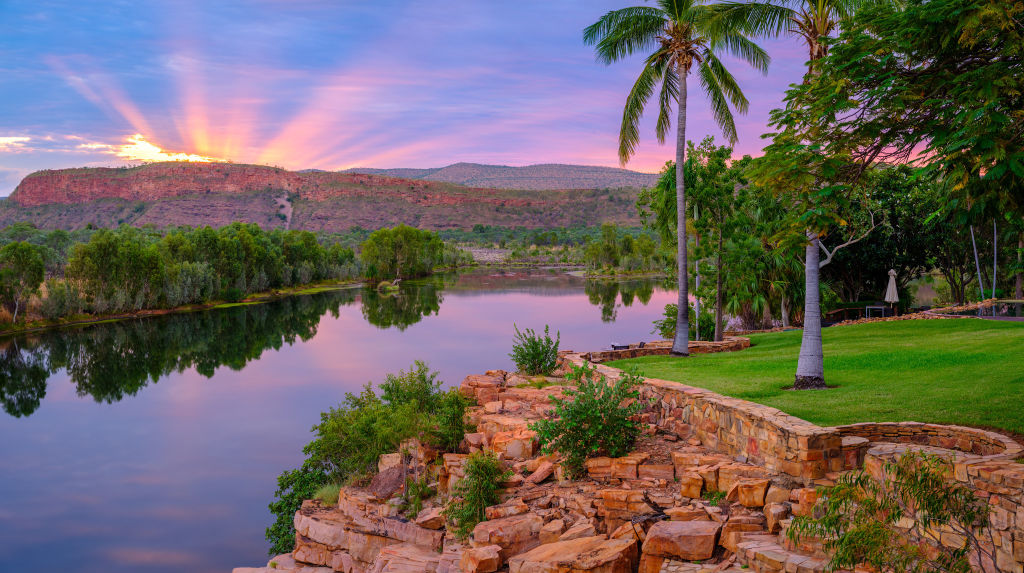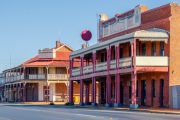
Historic deal sees land returned to Indigenous owners and leased back to tourism operator
When the new owner of the Kimberley’s iconic El Questro outback tourism operation visited the property, he was shocked to take tours and listen to stories not of the ancient Aboriginal dreamtime of the area, but instead of its white pastoral history.
In the four weeks he spent on the Gibb River Road, he heard a huge amount about land and cattle and settlers, and pretty much nothing about the region’s rich Indigenous culture.
“I felt very strongly that we shouldn’t be talking all the time about cows and white men but about, instead, the cultural value of the land and what it means to the traditional owners,” said Grant Wilckens, the founder of the G’Day Group, Australia’s largest regional accommodation provider which last year added El Questro to its portfolio.
“I had one of the elders with me and we did a smoking ceremony and she showed me some secret areas with the most amazing rock art. So I asked why we couldn’t show our guests at the property such incredible places, and was told we’d never had an Indigenous Land Use Agreement (ILUA), so no one was allowed to talk about culture. It was forbidden.”
As a result, Wilckens launched into talks with the Wilinggin Aboriginal Corporation and the West Australian government and, after 18 months of negotiations, the three parties ended up striking a historic land deal. In an Australian first, the agreement between a government, a local Indigenous corporation and a private business returned land to its traditional owners, converted it from a pastoral lease to freehold and reserve, and leased it back for 99 years to the tourism operator.
“It was really a win-win-win,” Wilckens said. “With Aboriginal owners, our tourists will now be able to have a much broader range of activities and hear the cultural stories and history of the region.
“And not only does this return lands to the traditional owners after 120 years, it provides the local community with significant economic benefits through a commercial lease arrangement, ongoing training and employment for the young people and opportunities to establish cultural tourism experiences supported by an experienced industry player.”
He added that it was his hope to see tours run not by backpackers but by “local Indigenous people with a real passion for the region”.
The deal agreed on Wednesday, resolves the complex, longstanding legal issues with the land operated on a pastoral lease for a mostly tourism business. Now under Aboriginal control, the 3500 head of livestock can be moved on from the property to allow for the restoration, and improved sustainability, of the natural environment.
Wilinggin Aboriginal Corporation chair Arnold Sahanna welcomed the agreement. “Since the Ngarinyin people achieved their Native Title in 2004 we have endeavoured to build a contemporary Ngarinyin Society capable of sustaining our Wanjina cultural values,” he said. “That means building a sustainable economic base for our community and regaining control of our land without impeding the right and interests of our neighbours.
“This ILUA that we are now entering into delivers on all these aspects of our ambitions as a First Nations people. This agreement and the model developed for collaborative development outcomes for the Kimberley is a solid achievement that we hope our young people will see as a way forward for our community to regain our place at the table of decision-making in matters that impact on our lives as the traditional owners of this part of the country.”
The 165-hectare El Questro, with its historic homestead, its station surrounded by boab trees, wildlife and rugged landscapes, and the stunning Chamberlain and Emma Gorges, was first established as a wilderness tourist destination in 1991 by English-Australian couple Will and Celia Burrell. Previously, it had been a cattle station.
It changed hands several times, most recently being owned by US business Delaware North, before being acquired by the G’day Group, which added it to its portfolio of around 300 properties around the country, bringing it back into Australian hands after more than a decade of foreign ownership.
Now Wilckens hopes the agreement will provide a template for other tourism ventures to also return land to traditional owners and lease it back to tour operators with Indigenous guides and content in collaboration with native title holders.
“This is the first time something like this has been done in Australia with three parties, including the state government,” he said.
“As a business, we are committed to a long-term strategy of sustainability and deeper connection with traditional owners right across Australia and we are hopeful this agreement can serve as a framework for other tourism operators and pastoralists, ensuring that Indigenous rights to land are at the forefront. It’s quite an amazing transaction, and I hope there will be more to come.”
The G’day Group also owns the Kings Canyon Resort – which is currently undergoing a $15 million renovation – the Undara Experience in tropical North Queensland, an eco-friendly glamping resort in the Rottnest Island dunes and the Discovery Park Cradle Mountain property, with a near-$20 million redevelopment in the planning. It’s also the owner of the Discovery Holiday Parks network and the G’day Parks brand.










